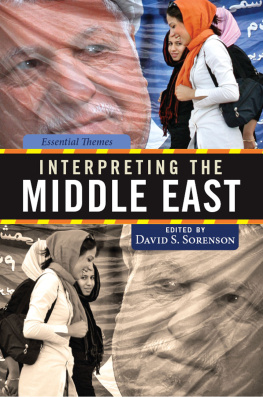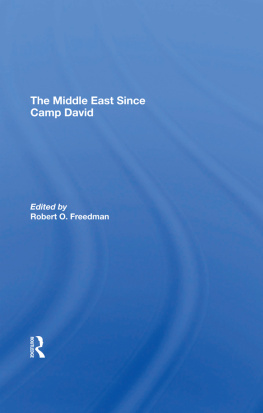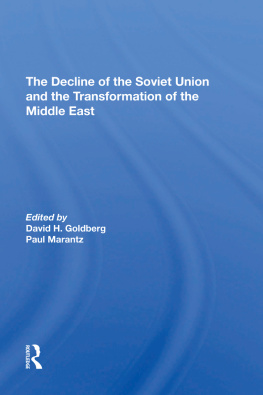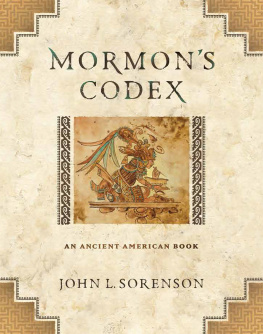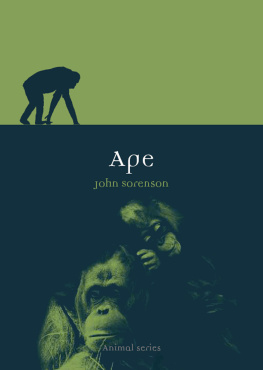Interpreting the Middle East
INTERPRETING THE MIDDLE EAST
Essential Themes
edited by
DAVID S. SORENSON
Air War College
First published 2010 by Westview Press
Published 2018 by Routledge
711 Third Avenue, New York, NY 10017, USA
2 Park Square, Milton Park, Abingdon, Oxon OX14 4RN
Routledge is an imprint of the Taylor & Francis Group, an informa business
Copyright 2010 Taylor & Francis
All rights reserved. No part of this book may be reprinted or reproduced or utilised in any form or by any electronic, mechanical, or other means, now known or hereafter invented, including photocopying and recording, or in any information storage or retrieval system, without permission in writing from the publishers.
Notice:
Product or corporate names may be trademarks or registered trademarks, and are used only for identification and explanation without intent to infringe.
Every effort has been made to secure required permissions to use all images, maps, and other art included in this volume.
Set in 10.5 point Adobe Garamond
Library of Congress Cataloging-in-Publication Data
Sorenson, David S., 1943
Interpreting the Middle East : essential themes / David S. Sorenson.
p. cm.
Includes bibliographical references and index.
ISBN 978-0-8133-4440-9 (alk. paper)
1. Middle EastPolitics and government21st century. 2. Middle EastEconomic conditions21st century. 3. Middle EastSocial conditions21st century. I. Title.
DS63.1.S674 2010
ISBN 13: 978-0-8133-4440-9 (pbk)
CONTENTS
, David S. Sorenson
, Onn Winckler
, Glenn E. Perry
, Dafna H. Rand
, David S. Sorenson
, Chantel Pheiffer and Gregory White
, Clement M. Henry
, Amy Elizabeth Young
, Raymond William Baker
, Christopher Hemmer
, Yahia H. Zoubir
, Eric Davis
, Manochehr Dorraj
, Steve Yetiv
TO THE POTENTIAL instructor who is considering adopting this book for class, this is an invitation to read the preface and introduction and judge whether it meets your needs. For the student or the bookstore customer who is opening this book for the first time, this is your invitation to explore the most significant issues that impact both the Middle East and much of the rest of the world.
I chose the contributors for this volume for their ability to generate a chapter that would be informative, incisive, current, and relevant to the debates and discussions revolving around the Middle East. Some are old friends, but most do not know me personally. What they all have in common is that they are internationally recognized experts in their fields. Outside of that criterion, they range considerably. Some have been in the field of Middle East studies for many decades, while others are just starting what will be distinguished careers. Some are Americans, others hold different-color passports. Their ethnicity, native tongue, or nationality did not matter to me; all that mattered was that they delivered a quality product within a relatively short span of time. I am convinced that they did, though it will be up to the readers and critics to judge for themselves.
I can promise that the chapters in this collection are timely, significant, and often controversial. Most involve not only additions to previous scholarship, but laborious efforts in the countries where the authors carried out their fieldwork. Their work is the most up-to-date research into political change, Middle East demographics, economic reform, civil-military relations, post-2003 change in Iraq, the latest thinking on Iran, and other pertinent matters that will benefit both students and professionals, along with the informed citizen.
I thank my editor, Karl Yambert of Westview Press, and my colleagues Chris Hemmer and Evelyn Early, for lengthy discussions and careful readings of my material. I alone am responsible for remaining shortcomings and errors.
: THE MIDDLE EAST AND NORTH AFRICA
David S. Sorenson
THIS EDITED BOOK provides an introduction to the modern Middle East using five principal themes intended to capture the essence of the contemporary Middle East. Each section of the book represents an issue area that students of the region need to become familiar with: features of the modern Middle East, including demographic issues and the impact of historical memory; interpreting politics in the Middle East, which has chapters on political change and civil-military relations; economic development, where the pertinent chapters discuss the changing political economy of the Middle East; interpreting the social context of the Middle East, with contributions on gender and religion in the region; and interpreting international issues in the Middle East, the longest section. It covers the Israeli-Palestinian dispute, the Western Sahara conflict, the aftermath in Iraq after 2003, Iranian regional interests, and the international implications of Middle East oil. The books purpose is broad but simple: to familiarize students of the region with its essential features and to help them understand the debates that frame those features.
PRESENTING THE MIDDLE EAST: THINGS TO THINK ABOUT
Each chapter in this collection assumes some familiarity with the issues and background.
The Middle East itself is a complex map of different countries, languages, religions, and traditions. It is easy to stereotype, but difficult to capture. There are few constants: Most of the occupants of the region speak Arabic, but there are other major languages as wellPersian (or Farsi), Hebrew, and Turkish, along with dozens of minor languages. Millions of Middle East inhabitants speak Armenian, Berber, Kurdish, Aramaic, and other ancient languages. A majority of the regions citizens are Muslim, but there are numerous sects of Islam, plus other populations of sects sometimes but not universally recognized as Islamic: the Druze, the Alawi (the Alevi in Turkey), and the Imbadi in Oman, to name but a few. A majority of Muslims are Sunni, but around 15 percent are Shia, and those two major branches have offshoots, along with adherence to different schools of Islamic jurisprudence. Most Shia follow the Twelver or










